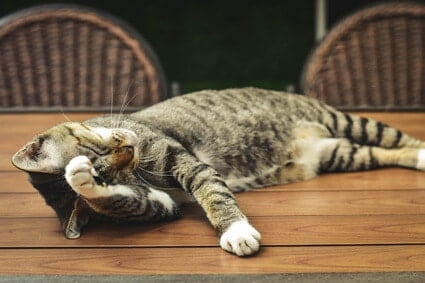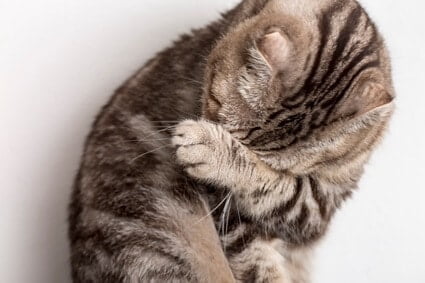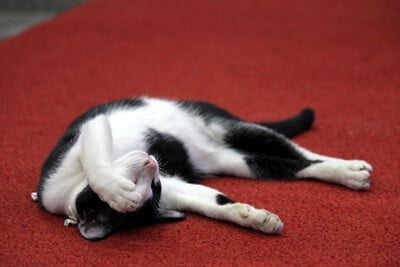Little scientific research has been conducted into how cats experience headaches. However, much of what we know about how and why humans experience headaches also applies to domesticated house cats.
Cats get tension headaches, cluster headaches, and migraines. However, it’s not easy to tell when a headache occurs. When a cat has a headache, it will hide its pain and seclude itself where it feels safe. The causes of headaches in cats include dehydration, heat exhaustion, trauma, and a loss of appetite.
Treating feline headaches involves providing a cool, quiet, and dark place where a cat can recover in peace. Offering food and water is also beneficial. If a headache persists or other worrisome symptoms arise, you should consult a vet.
Do Cats Ever Get Headaches?
Cats do get headaches, but we don’t notice them because of how cats react to pain. There is also the fact that humans can communicate when they’re in pain, but cats can’t. So, a cat’s instinct is always to conceal its discomfort.
A basic definition that encompasses the many types of headaches in cats is a pain in any region of the head. This pain can vary in severity, locality, and duration. We can deduce the type of headache by observing the symptoms. Headaches can be broken into two categories:
- Primary headaches: These are harmless, although painful, but aren’t a symptom of another health issue.
- Secondary headaches: As defined by The Journal of Headache and Pain, these are linked to and caused by a health issue or trauma. Secondary headaches can be harmless or dangerous.
Most research into headaches has been performed on humans. However, we do know that animals, including cats, get headaches. Research is limited but evolving. Before we get into how headaches manifest in domesticated cats, let’s look into the main types of headaches and their causes:
Can Cats Get Tension Headaches?
Tension headaches are one of the most common primary headaches that cats experience. Tension headaches are described as dull, aching sensations that usually encompass your entire head. The most common cause of a tension headache is stress. Other causes can include:
- Dehydration
- Exhaustion
- Poor posture
- Squinting
- Bright light
- Missed meals
- Tightened muscles
Can Cats Get Migraines?
Migraines manifest as an intense pain pulse from deep within your head, usually only on one side. These types of headaches can cause you to be sensitive to light and sound and may also trigger nausea and vomiting.
People may also see flashing or shimmering lights, stars or experience blind spots before a migraine settling in. Obviously, we cannot ask a house cat what it sees to diagnose a migraine.
What can trigger a tension headache can also trigger a migraine. This includes poor sleep, dehydration, and missed meals. Other causes of migraines include exposure to chemicals, hormone fluctuations, and even some foods.
Can Cats Get Cluster Headaches?
So named for its habit of occurring in clustered series, cluster headaches cause a severe burning and piercing pain. Typically, this pain is behind one eye or local to one side of the face.
The Lancet goes as far as to say that cluster headaches are one of the most severe pains known to mankind. Those ailed with these headaches will experience them in a series for an unspecified amount of time.
Individual headaches can last for anywhere between 15 and 60 minutes. Clusters can be contained to hours, days, weeks, or months. In between clusters are periods of relief.
One experiencing cluster headaches may also exhibit redness, flushing, swelling, sweating, nasal congestion, and tearing eyes. These symptoms are often located to the half of the face experiencing the pain.
Researchers don’t know what causes cluster headaches in people, let alone if house cats experience them.
How To Tell If Your Cat Has A Headache
We know that cats, alongside other animals, do ail from them. Determining whether your cat has a headache relies on knowing how cats respond to pain.
Many of the symptoms listed above for each type of headache rely on the patient describing how they feel. A cat cannot do the same. It will rely on you observing how your cat behaves to notice that something might be wrong.
This can be especially difficult to notice, though, as cats tend to hide their pain. This is thought to be a survival instinct. A by-product of a time before domestication, where weakness would have made a cat more vulnerable to other predators or rival cats.
Looking for signs of pain is the first step in determining if your cat has a headache. Most cats will exhibit one or more of the following signs, no matter how it normally behaves.

Hiding Discomfort
A cat’s natural instinct when it feels unwell due to illness or injury is to hide, even from its owner. Often, a cat will seek out a place of seclusion and comfort. It may hide where none can see, or it may isolate itself where none can reach. Some cats naturally prefer to be alone for the better part of the day, and self-isolation isn’t always a sign that something is wrong.
If you notice your cat doing this alongside any of the behaviors below, be sure to monitor it closely.
Appetite Loss
Headaches of many kinds can result in a reduced appetite. Pain can dampen an appetite. Migraines can also cause nausea, which will reduce a cat’s willingness to eat. A loss in appetite, or an outright refusal to eat, is a strong indicator that your cat is unwell.
A myriad of other conditions can also cause appetite loss. If your cat refuses food for over 24 hours, get it to a vet. Cats convert protein into energy, so missing meals will cause them to begin losing weight.
Sensitivity To Touch
Few like to be touched when in pain. If your cat withdraws from your touch, where it normally wouldn’t, then it may have a headache. The same can be said for other people or animals in their family.
Alone, this symptom may not actually be a symptom. House cats are social creatures when properly socialized. Still, most do like some time alone. Keep a close eye out for other signs of pain or illness if the cat repeatedly withdraws from your touch throughout the day.
Lethargy
Pain puts a serious damper on anyone’s motivation to do anything. Headaches, especially more severe ones, can cause your cat to be lethargic until the pain passes.
A cat will naturally spend the better part of its day lazing around. Check if your cat is unmotivated or lethargic by tempting it to play with pets or with food.
Panting
Cats only pant when overheated. Migraines can result in fever-like symptoms and a raised temperature, although we cannot determine if the same is true for cats. Some suggest that cats may experience a heightened temperature during headaches, prompting a panting response.
If your cat is panting and it isn’t overheated or hasn’t recently been very active, then something could well be wrong. It may be a headache or something more serious. Two things to note:
- Cat’s naturally run a body temperature between 101-102.5° F.
- Don’t confuse panting with the open-mouthed, grimace-like action of the flehmen’s response. This is when a cat has found an interesting smell and is exposing its fine-tuned olfactory system to the air.
Red Gums
Reddened gums are symptoms of other ailments which can also cause headaches. This could be an infection in the mouth, tooth pain, or overheating.
Restlessness
Not every cat will react to pain by hiding. Some cats will pace, fidget, vocalize, and otherwise act restlessly without an obvious cause. This can be a sign of pain or distress. The source of these feelings could be a headache.
Changes in Breathing
Asides from open-mouthed panting, cats may respond to pain with shallow, rapid breaths. This is really only a symptom of pain if the cat has been largely inactive before a change in breathing.
Keep a close eye on the cat. If its breathing does not return to its normal rate within 5 minutes, check it over for other signs of illness or injury.
Facial Expression
A change in facial expression may not seem like something to watch for in a cat. However, cats can be quite expressive, even without projecting human emotions onto them.
A cat in pain may have squinted eyes. This will likely appear if the headache is light-sensitive, meaning the cat has a migraine. Squinted eyes may also indicate pain in the head itself.
Pupils can also indicate both if the cat is in pain and where that pain might be. Dilated pupils could mean that the cat is in pain anywhere.
Constricted pupils indicate that the pain is local to the eye. Take into account the cat’s mood and the room’s ambient light, as both will affect the pupil.
Causes of Headaches in Cats
Headaches have numerous causes, even if many remain elusive to researchers. The knowledge we have can largely be applied to cats as well. Observation, and a vet’s consultation, will be able to further narrow down the cause of your house cat’s headache.
Still, several things can cause headaches in cats. You yourself can make adjustments to limit how frequently your cat has one.
Dehydration
Headaches can be the result of dehydration. Ensuring that your cat always has access to fresh, clean water will go a long way to preventing headaches.
If your cat is fussy about drinking, try including more wet food in its diet, offering it gravy or sauce treats, or using a waterfall dish. This latter option can be the most effective, long-term trick. Cats may avoid drinking from standing water.
You can also move its water dish further away from its food bowls. Cats may instinctively avoid water near their food, as rotting food can taint the water and make it unsafe to drink.

Heat Exhaustion
We’ve all felt the hot press of the unforgiving sun. Heat exhaustion, alongside the other symptoms of heatstroke, results in a headache for cats. Heat exhaustion can be deadly if left unresolved.
Remove your cat from the hot environment and dampen its fur with tepid water – not icy water, as this can cause it to go into shock. Ensure that it is exposed to ambient temperature airflow, such as a fan.
Tumors
Persistent headaches can indicate tumors. As tumors grow, they press on the surrounding tissues. This pressure and inflammation can result in a headache.
Loss of Appetite
Not only is a loss of appetite a symptom of having a headache, but it can also be a cause.
Many people have experienced headaches, only to eat something and find that the headache has disappeared. The same goes for your cat. If your cat is refusing to eat, it may develop a headache.
Try offering different foods, warming foods up, or offering treats to entice your cat to eat.
Trauma
Trauma to the head or neck, in the past or recently, can result in headaches. This is usually attributed to pulled muscles.
Collars
Collars, if they’re too heavy or tight, can cause muscle strain. This may result in a headache. Make sure that your cat’s collar, if it wears one, is of the appropriate size and not overly tight. Remove any unnecessary decorations, such as bells, to cut down on weight.
Collars may also get caught on furniture or other objects. Trauma to the head or neck can result, which may cause a headache.
What Can I Give My Cat For A Headache?
Treating headaches involves following the same steps that you would take to treat your own headache. That is, except for pain medication, which should never be given to a cat without consulting a vet.
Give your cat to a cool, quiet, and dark place where it can be comfortable, such as your bedroom. Offer it water and a small amount of food. You can also offer it some light petting, which may help it to relax.


Would a cat actually cover his eyes with his paws? My guy was sick last week. Our vet couldn’t find anything wrong with him but he was doing everything you mentioned in your article. She gave him something for nausea and injected fluid under his skin and told us to bring him back if he got worse. I get migraines and I had one that day. I swear he was doing pretty much the same things I was. He stayed in a dark, cool area and if any light came on he covered his eyes. I called our vet and asked if it was possible that he had a headache but she didn’t know if cats got them. He was like that for almost two days but is back to his normal self.